USS MULLINNIX DD-944
 1981 Middle East
1981 Middle East 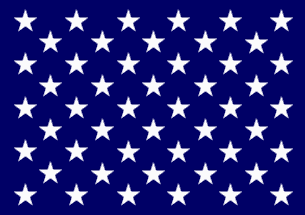
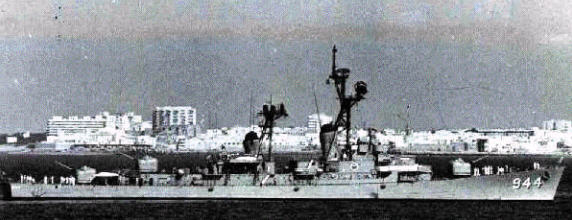
USS Mullinnix - Actual Date Unknown
Background (Qaddafi's "Line of Death")
In 1973, Libya claimed the Gulf of Sidra as a closed bay and part of its territorial waters. This prompted the United States to conduct Freedom of Navigation (FON) operations in the area since the claim did not meet the criteria established by international law. Libya often confronted U.S. forces in and near the gulf, and on two occasions its fighter jets opened fire on U.S. reconnaissance flights off the Libyan coast; once in early 1973 and again in late 1980. FON operations intensified when Ronald Reagan became president.
In August 1981, Reagan authorized a large naval force led by a pair of aircraft carriers, USS Forrestal and USS Nimitz, to deploy to the disputed area. The two carriers had embarked a total of four interceptor squadrons: VF-74 "Be-Devilers" and VMFA-115 "Silver Eagles", flying F-4 Phantoms from Forrestal, and VF-41 "Black Aces" and VF-84 "Jolly Rogers", flying F-14 Tomcats from Nimitz. The Libyan Air Force responded by deploying a high number of interceptors and fighter-bombers. Early on the morning of 18 August, when the U.S. exercise began, at least three MiG-25 'Foxbats' approached the U.S. carrier groups, but were escorted away by American interceptors. The Libyans tried to establish the exact location of the U.S. naval force. Thirty-five pairs of MiG-23 'Floggers', MiG-25s, Sukhoi Su-20 'Fitter-Cs', Su-22M 'Fitter-Js' and Mirage F1s flew into the area, and were soon intercepted by seven pairs of F-14s and F-4s. U.S. Naval Intelligence later assessed that a MiG-25 may have fired a missile from 18 miles (29 km) away at U.S. fighter aircraft that day.
Incident (19 August 1981)
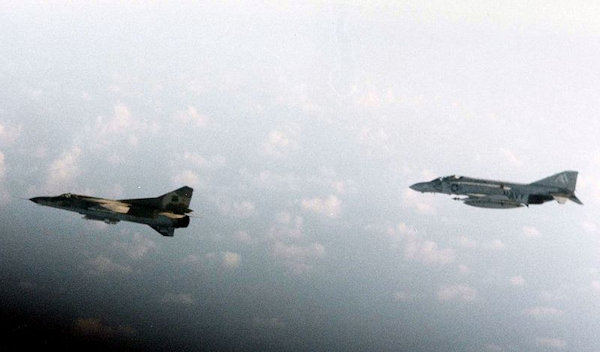
On the morning of 19 August, after having diverted a number of Libyan "mock" attacks on the battle group the previous day, two F-14s from VF-41 "Black Aces", Fast Eagle 102 (CDR Henry 'Hank' Kleemann/LT David 'DJ' Venlet) (flying BuNo 160403) and Fast Eagle 107 (LT Lawrence 'Music' Muczynski/LTJG James 'Luca' Anderson) (in BuNo 160390), were flying combat air patrol (CAP), ostensibly to cover aircraft engaged in a missile exercise. However, U.S. Navy Commander Thompson S. Sanders wrote in Air & Space/Smithsonian that his S-3A Viking's mission was the real precursor to this incident. Sanders was ordered to fly his Viking in a "racetrack" orbit (oval pattern) inside Gaddafi's claimed zone but outside the internationally recognized 12-mile (19 km) territorial water limit to try to provoke the Libyans to react. An E-2C Hawkeye alerted Sanders that two Sukhoi Su-22 fighters had taken off from Ghurdabiyah Air Base near the city of Sirte.
In the picture above, a U.S. Navy McDonnell F-4J Phantom II of Fighter Squadron VF-74 "Be-Devilers" escorting a Libyan Mikoyan-Gurevich MiG-23 over Gulf of Sidra in August 1981.
The Hawkeye directed the F-14s to intercept while Sanders dove to an altitude of 500 feet (150 m) and flew north to evade the Libyan aircraft, an experience Sanders found stressful because the S-3A was not equipped with a threat warning receiver, nor with any countermeasures, a deficiency later remedied on the S-3B. The two F-14s set up for an intercept as the contacts headed north towards them. Only a few seconds before the crossing, at an estimated distance of 300 m, one of the Libyans fired an AA-2 "Atoll" at one of the F-14s, but missed. Then the two Su-22s split as they flew past the Americans, the leader turning to the northwest and the wingman turning southeast in the direction of the Libyan coast. The Tomcats evaded the missile and were cleared to return fire by of their rules of engagement, which mandated self-defense on the initiation of hostile action. The Tomcats turned hard port and came behind the Libyan jets. The Americans fired AIM-9L Sidewinders; the first kill is credited to Fast Eagle 102, the second to Fast Eagle 107. Both Libyan pilots ejected.
Prior to the ejections, a U.S. electronic surveillance plane monitoring the event recorded the lead Libyan pilot reporting to his ground controller that he had fired a missile at one of the U.S. fighters and gave no indication that the missile shot was unintended. The official U.S. Navy report states that both Libyan pilots ejected and were safely recovered, but in the official audio recording of the incident taken from USS Biddle, one of the F-14 pilots states that he saw a Libyan pilot eject, but his parachute failed to open.
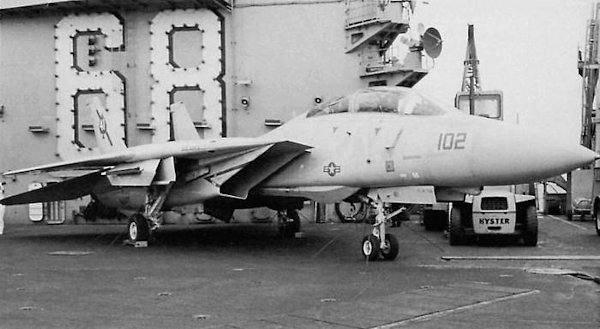
In the picture at left, Fast Eagle 102, one of the two F-14 Tomcats on the deck of the USS Nimitz immediately following the incident.
Less than an hour later, while the Libyans were conducting a search-and-rescue operation for their downed pilots, two MiG-25s entered the airspace over the Gulf, headed towards the U.S. carriers at Mach 1.5 and conducted a mock attack in the direction of USS Nimitz. Two VF-41 Tomcats headed towards the Libyans, which then turned around. The Tomcats turned home, but had to turn around again when the Libyans headed towards the U.S. carriers once more. After being tracked by the F-14s' radars, the MiGs finally headed home. One more Libyan formation ventured out into the Gulf towards the U.S. forces later that day.
Fast Eagle 102 (BuNo 160403) is now on display at the Commemorative Air Force Museum in Midland, Texas. The restored F-14 was unveiled in a ceremony on August 26, 2016. Vice Admiral Dave Venlet cut the first tape. Fast Eagle 107 (BuNo 160390) was destroyed in an accident on 25 October 1994.
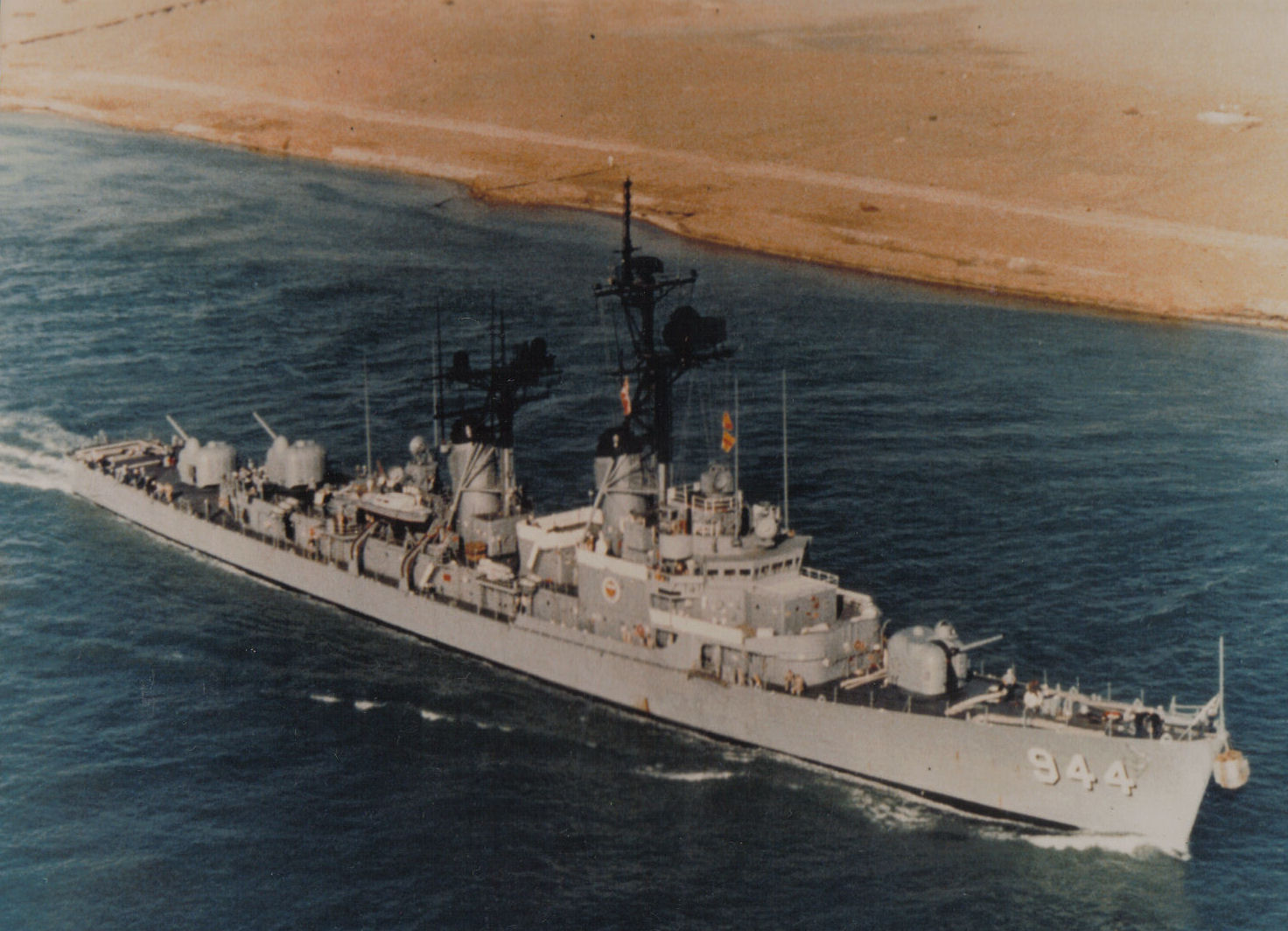
Mullinnix steaming through Suez Canal - 1980s


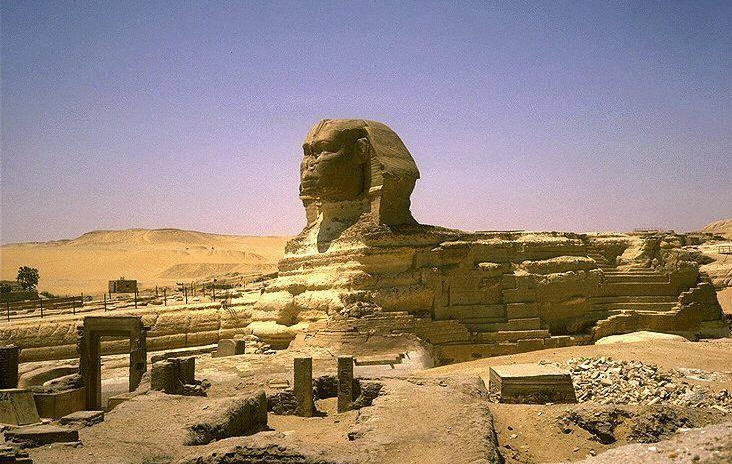
The USS Mullinnix went to Newport, RI for a day prior to going to East Boston for a yard overhaul in January 1981. She picked up a busload of school kids from "Eastie" who had come down to ride the ship back as one of CDR Yankura’s public relations acts. A good time was had by all, as we got to show the children around the ship and then let them sample some good old navy chow at lunch. The MS’s were in rare form, as the children seemed to truly enjoy their meal.
The Mullinnix arrived in Newport in the mid-afternoon and left the next morning.
When the MUX was in her final overhaul in Boston 1981, the shipyard was directly across the harbor from the CONSTITUTION. There was one crewman from the CONSTITUTION who transferred to the MUX (while she was in the yards) by the name of BM2 Silver. He stood several mid-watches with John Hardin and was one great guy.

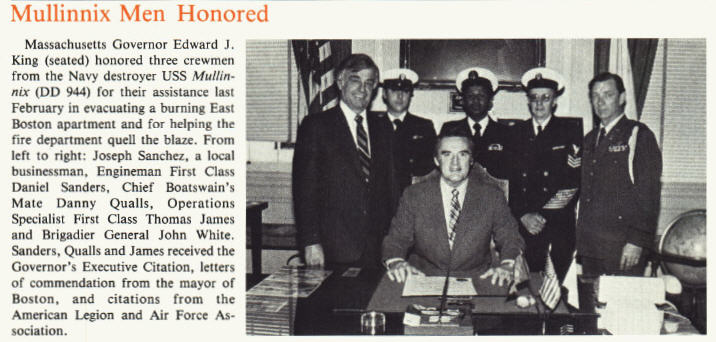
All Hands Magazine - September 1981
(Yard period in East/South Boston before Last Cruise)

Radioman Third Class Jose A. Garcia from Laredo, TX remembers walking off the Mullinnix on May 30, 1981 while she was in the ship yard at East Boston, Mass.
RM Monroe joined the Mullinnix in 1981 in Beirut. The ship had been there for 6 moths and ready for shore leave!!! Mullinnix was on a combination Med/Indian Ocean tour. Monroe became a Shell Back on that cruise along with all hands on board. He says that is a memory he’ll never forget!!!!(or want to relive!).

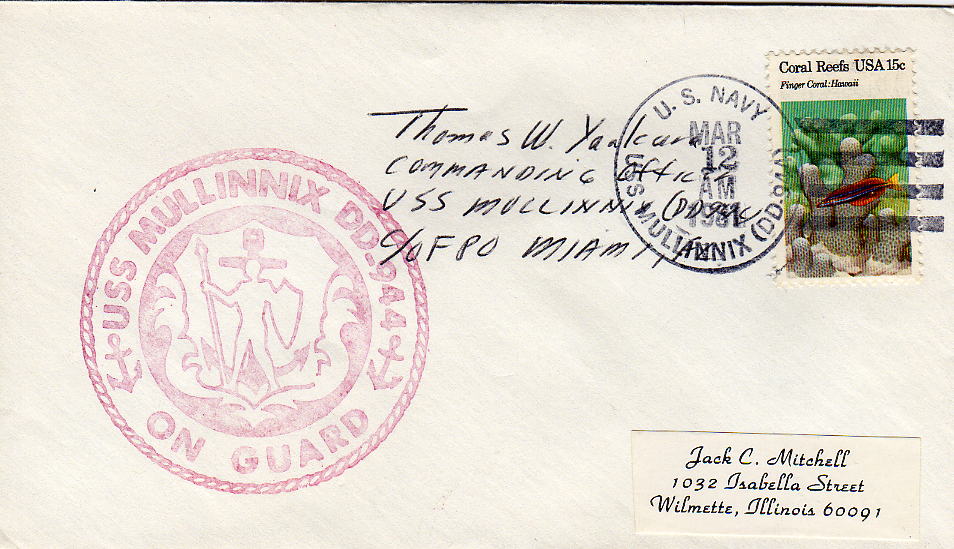
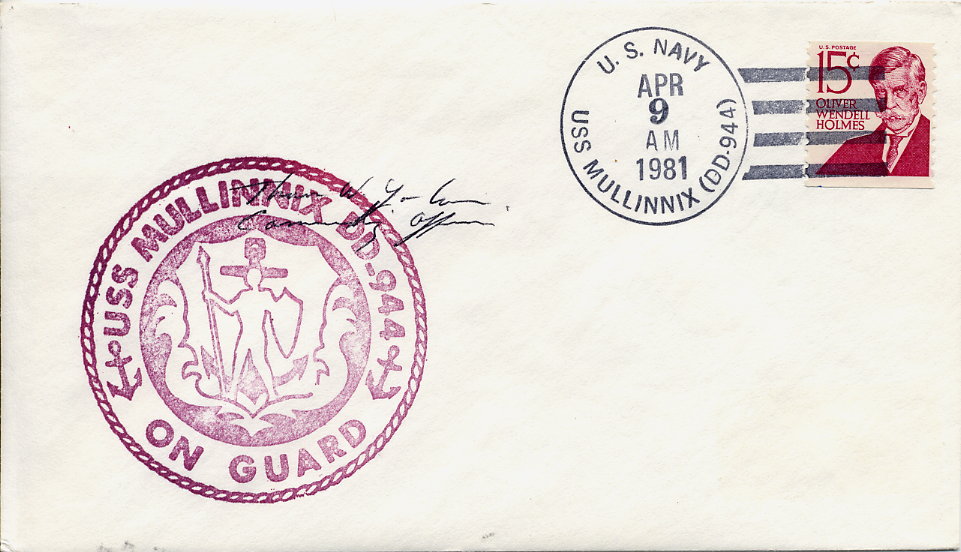
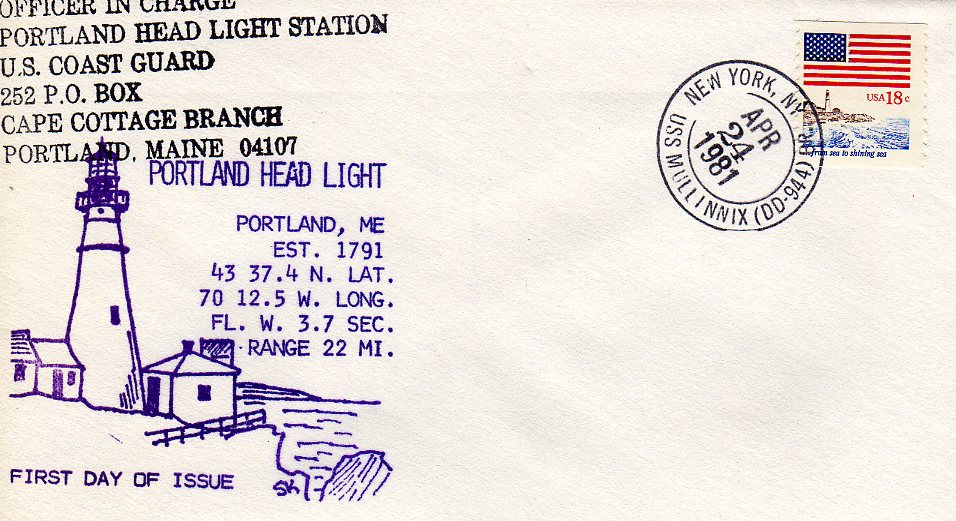
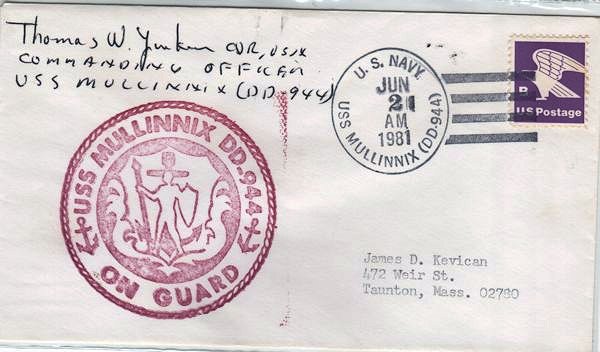
Signed by Commanding Officer
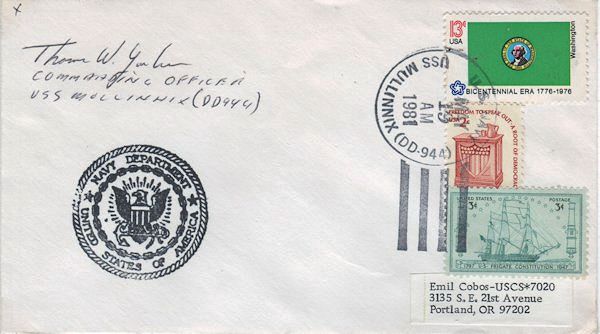
Back to Ship History
Home
© 2004 by Frank Wood, All rights reserved
 1981 Middle East
1981 Middle East 
 1981 Middle East
1981 Middle East 















